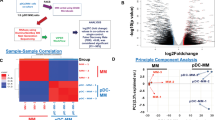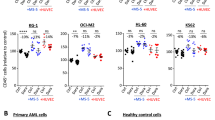Abstract
Malignant plasma cells (PC) in human multiple myeloma (MM) are retained in the bone marrow (BM) microenvironment. Using HUTS21 monoclonal antibody that reacts with active CD29 integrin, we demonstrate that this active form is tightly regulated by divalent cations and soluble CD106 (sCD106) contained in the BM plasma. Moreover, we also show that in vivo expression of the active CD29 on PC was clearly diminished in a minority of MM cases (HUTS21− patients). HUTS21− cells were refractory to the addition of either normal allogeneic BM plasma or optimal concentrations of exogenous divalent cations and recombinant sCD106. Furthermore, a lower binding to fibronectin was detected in comparison with HUTS21+ PC. On the other hand, although HUTS21− PC showed a reduced amount of total (active+inactive) CD29, western-blot assays demonstrated that these clonal PC contained the two species of CD29, with molecular masses of 110 and 130 kDa, which were expressed on normal or HUTS21+ PC. Finally, we detected a clear association between the presence of HUTS21− PC in the BM and an increased percentage of circulating PC with a high proliferative index, emphasizing the essential role of CD29 in the pathogenesis and progression of this disease.
This is a preview of subscription content, access via your institution
Access options
Subscribe to this journal
Receive 12 print issues and online access
$259.00 per year
only $21.58 per issue
Buy this article
- Purchase on Springer Link
- Instant access to full article PDF
Prices may be subject to local taxes which are calculated during checkout






Similar content being viewed by others
References
Hallek M, Bergsagel PL, Anderson KC . Multiple Myeloma: increasing evidence for a multistep transformation process. Blood 1998; 91: 3–21.
Billadeau D, Van Ness B, Kimlinger T, Kyle RA, Therneau TM, Greipp PR et al. Clonal circulating cells are common in plasma cell proliferative disorders: a comparison of monoclonal gammopathy of undetermined significance, smoldering multiple myeloma, and active myeloma. Blood 1996; 88: 289–296.
Uchiyama H, Barut BA, Chauhan D, Cannistra SA, Anderson KC . Characterization of adhesion molecules on human myeloma cell lines. Blood 1992; 80: 2306–2314.
Sanz-Rodríguez F, Ruiz-Velasco N, Pascual-Salcedo D, Teixid J . Characterization of VLA-4-dependent myeloma cell adhesion to fibronectin and VCAM-1. Br J Haematol 1999; 107: 825–834.
Olson DL, Burkly LC, Leone DR, Dolinski BM, Lobb RR . Anti-α4 integrin monoclonal antibody inhibits multiple myeloma growth in a murine model. Mol Cancer Ther 2005; 4: 91–99.
Pellat-Deceunynck C, Barille S, Puthier D, Rapp MJ, Harousseau JL, Bataille R et al. Adhesion molecules on human myeloma cells: significant changes in expression related to malignancy, tumor spreading, and immortalization. Cancer Res 1995; 55: 3647–3653.
Humphries MJ . Integrin activation: the link between ligand binding and signal transduction. Curr Opin Cell Biol 1996; 8: 632–640.
Masumoto A, Hemler ME . Multiple activation states of VLA-4. Mechanistic differences between adhesion to CSl/fibronectin and to vascular cell ddhesion molecule-I. J Biol Chem 1993; 268: 228–234.
Chigaev A, Zwartz G, Graves SW, Dwyer DC, Tsuji H, Foutz TD et al. 4β1 integrin affinity changes govern cell adhesion. J Biol Chem 2003; 278: 38174–38182.
Luque R, García-Trujillo JA, Cámara C, Moreno A, Eiras P, Roy G et al. CD106 and activated-CD29 are expressed on myelomatous bone marrow plasma cells and their downregulation is associated with tumour progression. Br J Haematol 2002; 119: 70–78.
García-Gila M, Cabañas C, Garcia-Pardo A . Analysis of the activation state of α4β1 in human B cell lines derived from myeloma, leukemia or lymphoma. FEBS Lett 1997; 418: 337–340.
Mitra SK, Schlaepfer DD . Integrin-regulated FAK-Src signaling in normal and cancer cells. Curr Opin Cell Biol 2006; 18: 516–523.
Robillard N, Pellat-Deceunynck C, Bataille R . Phenotypic characterization of the human myeloma cell growth fraction. Blood 2005; 105: 4845–4848.
IMWG. Criteria for the classification of monoclonal gammopathies, multiple myeloma and related disorders: a report of the International Myeloma Working Group. Br J Haematol 2003; 121: 749–757.
Luque R, Brieva JA, Moreno A, Manzanal A, Escribano L, Villarrubia J et al. Normal and clonal B lineage cells can be distinguished by their differential expression of B cell antigens and adhesion molecules in peripheral blood from multiple myeloma (MM) patients—diagnostic and clinical implications. Clin Exp Immunol 1998; 112: 410–418.
Goodwin AE, Pauli BU . A new adhesion assay using buoyancy to remove non-adherent cells. J Immunol Methods 1995; 187: 213–219.
Luque A, Gomez M, Puzon W, Takada Y, Sanchez-Madrid F, Cabañas C . Activated conformations of very late activation integrins detected by a group of antibodies (HUTS) specific for a novel regulating region (355-425) of the common β1 chain. J Biol Chem 1996; 271: 11067–11075.
Chow S, Hedley D, Grom P, Magari R, Jacobberger JW, Shankey TV . Whole blood fixation and permeabilization protocol with red blood cell lysis for flow cytometry of intracellular phosphorylated epitopes in leukocyte subpopulations. Cytometry A 2005; 67: 4–17.
Luo BH, Carman CV, Springer TA . Structural basis of integrin regulation and signaling. Annu Rev Immunol 2007; 25: 619–647.
Day ES, Osborn L, Whitty A . Effect of divalent cations on the affinity and selectivity of α4 integrins towards the integrin ligands vascular cell adhesion molecule-1 and mucosal addressin cell adhesion molecule-1: Ca2+ activation of integrin α4β1 confers a distinct ligand specificity. Cell Commun Adhes 2002; 9: 205–219.
Chen LL, Whitty A, Scott D, Lee WC, Cornebise M, Adams SP et al. Evidence that ligand and metal ion binding to integrin α4β1 are regulated through a coupled equilibrium. J Biol Chem 2001; 276: 36520–36529.
Slørdahl TS, Hov H, Holt RU, Baykov V, Syversen T, Sundan A et al. Mn2+ regulates myeloma cell adhesion differently than the proadhesive cytokines HGF, IGF-1, and SDF-1α. Eur J Haematol 2008; 81: 437–447.
Smith JW, Piotrowicz RS, Mathis D . A mechanism for divalent cation regulation of β3-integrins. J Biol Chem 1994; 269: 960–967.
Laudanna C, Kim JY, Constantin G, Butcher E . Rapid leukocyte integrin activation by chemokines. Immunol Rev 2002; 186: 37–46.
Sanz-Rodríguez F, Hidalgo A, Teixedó J . Chemokine stromal cell-derived factor-1α modulates VLA-4 integrin-mediated multiple myeloma cell adhesion to CS-1/fibronectin and VCAM-1. Blood 2001; 97: 346–351.
Chigaev A, Waller A, Amit O, Halip L, Bologa CG, Sklar LA . Real-time analysis of conformation-sensitive antibody binding provides new insights into integrin conformational regulation. J Biol Chem 2009; 284: 14337–14346.
Chan JR, Hyduk SJ, Cybulsky MI . Detecting rapid and transient upregulation of leukocyte integrin affinity induced by chemokines and chemoattractants. J Immunol Methods 203; 273: 43–52.
Bellis SL . Variant glycosylation: an underappreciated regulatory mechanism for beta1 integrins. Biochim Biophys Acta 2004; 1663: 52–60.
Pochec E, Lytinska A, Amoresano A, Casbarra A . Glycosylation profile of α3β1 changes with melanoma progression. Biochim Biophys Acta 2003; 1643: 113–123.
Seales EC, Jurado GA, Brunson BA, Wakefield JK, Frost AR, Bellis SL . Hypersialylation of β1 integrins, observed in colon adenocarcinoma, may contribute to cancer progression by up-regulating cell motility. Cancer Res 2005; 65: 4645–4652.
Evans RD, Perkins VC, Henry A, Stephens PE, Robinson MK, Watt FM . A tumor-associated β1 integrin mutation that abrogates epithelial differentiation control. J Cell Biol 2003; 160: 589–596.
Etzioni A . Genetic etiologies of leukocyte adhesion defects. Curr Opin Immunol 2009; 21: 481–486.
Harris ES, Shigeoka AO, Li W, Adams RH, Prescott SM, McIntyre TM et al. A novel syndrome of variant leukocyte adhesion deficiency involving defects in adhesion mediated by β1 and β2 integrins. Blood 2001; 97: 767–776.
Levkau B, Kenagy RD, Karsan A, Weitkamp B, Clowes AW, Ross R et al. Activation of metalloproteinases and their association with integrins: an auxiliary apoptotic pathway in human endothelial cells. Cell Death Differ 2002; 9: 1360–1367.
O’Toole TE, Mandelman D, Forsyth J, Shatill SJ, Plow EF, Ginsberg MH . Modulation of the affinity of integrin αIIbβ3 (GPIIb-IIIa) by the cytoplasmic domain of αIIb. Science 1991; 254: 845–847.
Larson RS, Hibbs ML, Springer TA . The leukocyte integrin LFA-1 reconstituted by cDNA transfection in a nonhematopoietic cell lines functionally active and not transiently regulated. Cell Regul 1990; 1: 359–367.
Van de Walle GR, Vanhoorelbeke K, Majer Z, Illyes E, Baert J, Pareyn I et al. Two functional active conformations of the integrin α2β1, depending on activation condition and cell type. J Biol Chem 2005; 280: 36873–36882.
Gomez M, Luque A, Del Pozo MA, Hogg N, Sanchez-Madrid F, Cabañas C . Functional relevance during lymphocyte migration and cellular localization of activated β1 integrins. Eur J Immunol 1997; 27: 8–16.
Rawstron A, Barrans S, Blythe D, Davies F, English A, Pratt G et al. Distribution of myeloma plasma cells in peripheral blood and bone marrow correlates with CD56 expression. Br J Haematol 1999; 104: 138–143.
Park CC, Zhang HJ, Yao ES, Park CJ, Bisell MJ . 1 integrin inhibition dramatically enhances radiotherapy efficacy in human breast cancer wenografts. Cancer Res 2008; 68: 4398–4405.
Greipp PR, Lust JA, O’Fallon WM, Katzmann JA, Witzig TE, Kyle RA . Plasma cell labeling index and beta2-microglobulin predict survival independent of thymidine kinase and C-reactive protein in multiple myeloma. Blood 1993; 81: 3382–3387.
Hose D, Reme T, Hielscher T, Moreaux J, Messner T, Seckinger A et al. Proliferation is a central independent prognostic factor and target for personalized and risk-adapted treatment in multiple myeloma. Haematologíca 2010; 96: 87–95.
Damiano JS, Cress AE, Hazlehurst LA, Shtil AA, Dalton WS . Cell adhesion mediated drug resistance (CAM-DR): role of integrins and resistance to apoptosis in human myeloma cell lines. Blood 1999; 93: 1658–1667.
Yang HH, Ma MH, Vescio RA, Berenson JR . Overcoming drug resistance in multiple myeloma: the emergence of therapeutic approaches to induce apoptosis. J Clin Oncol 2003; 21: 4239–4247.
Hatano K, Kikuchi J, Takatoku M, Shimizu R, Wada T, Ueda M et al. Bortezomib overcomes cell adhesion-mediated drug resistance through downregulation of VLA-4 expression in multiple myeloma. Oncogene 2009; 28: 231–242.
Acknowledgements
We thank Pilar Salillas, Eva Gallo, Francine Doat and Carmen Quellez for their excellent technical assistance. I also thank the scientific friends whose life and teaching inspired me like the blue and clear light of wisdom. Finally, I owe an unpayable debt for all my life to Ernesto Roldán Chala, who taught me so much about patience, perseverance and responsibility. This work was supported by the Spanish Fondo de Investigaciones Sanitarias (FIS) with the Grant G03/136. EMV was supported by a grant from the Hospital Ramón y Cajal Foundation.
Author information
Authors and Affiliations
Corresponding author
Ethics declarations
Competing interests
The authors declare no conflict of interest.
Additional information
Author Contributions
EM-V designed research, performed research, analyzed data; JAG-T designed research, performed research, analyzed data; ER-M analyzed data; LMV designed research, analyzed data; JC analyzed data; ER designed research, analyzed data, wrote the paper.
Rights and permissions
About this article
Cite this article
Martínez-Viñambres, E., García-Trujillo, J., Rodríguez-Martín, E. et al. CD29 expressed on plasma cells is activated by divalent cations and soluble CD106 contained in the bone marrow plasma: refractory activation is associated with enhanced proliferation and exit of clonal plasma cells to circulation in multiple myeloma patients. Leukemia 26, 1098–1105 (2012). https://doi.org/10.1038/leu.2011.335
Received:
Revised:
Accepted:
Published:
Issue Date:
DOI: https://doi.org/10.1038/leu.2011.335
Keywords
This article is cited by
-
Ablation of VLA4 in multiple myeloma cells redirects tumor spread and prolongs survival
Scientific Reports (2022)
-
Persistent CD49d engagement in circulating CLL cells: a role for blood-borne ligands?
Leukemia (2016)



